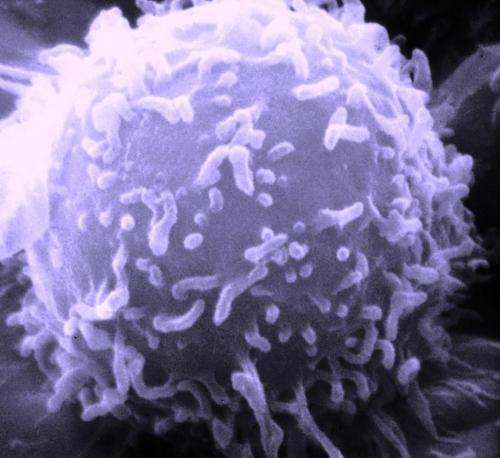March 21, 2016 report
FOXA1 found to control specificity of cancer cells

(Medical Xpress)—A team of researchers with the Mayo Clinic has learned more about how a transcription factor known as FOXA1 forms cancer-specific genomic identifiers and how it regulates gene expression differently among four very different types of human cancer cell lines. In their paper published in the journal Science Advances, the team describes how they used gene editing techniques and other tools to learn more about the unique binding process that allows the protein to regulate gene expression in the different types of cancers.
Scientists know that cancer doesn't grow in isolation, tumors, like other parts of the body are made of cells which depend on the same biological processes to regulate organogenesis as other tissues or organs. One of those processes is transcriptional regulation, where cells regulate the conversion of DNA sequences to RNA. In this new effort, the researchers looked at the protein coding gene FOXA1, which has been associated with several types of human cancers. More specifically, they looked into how just one transcription factor is able to form cancer-specific genomic changes to different types of cells, because it is important when trying to understand how tumors grow and because to date, it is still not very well understood.
The researchers started with a type of sequencing technology that allows for processing large numbers of genomes, which allowed them to see how FOXA1 targets genes in two different kinds of breast cancer cells as well as liver and prostate cancer cells—and that allowed them to see a previously unknown feature of the protein; tailored targeting and binding to DNA. The team then used the CRISPR- Cas9 genome editing technique to look deeper and found that cell-specific FOXA1 regulation was due to unique binding, genetic variations and/or possible non-genetic regulation, which added more evidence of FOXA1 controlling the process by which specific types of cancer cells develop.
After analyzing their work, the team developed a hypothesis to describe how they believe the process works, describing it as a progression that looks rather like what happens when a flower blooms. They suggest that the 'blooming' of certain transcription factors may be managed by the uniqueness of its genetic variations, its unique binding abilities and likely some other possible factors which may include other regulators and/or chromatin remodeling. The net result is more information regarding the mechanism behind the growth of cancer cells, which adds to an ever growing body of data that may one day reveal a means for controlling such growth and thus preventing cancer from causing harm.
More information: G. Zhang et al. FOXA1 defines cancer cell specificity, Science Advances (2016). DOI: 10.1126/sciadv.1501473
Abstract
A transcription factor functions differentially and/or identically in multiple cell types. However, the mechanism for cell-specific regulation of a transcription factor remains to be elucidated. We address how a single transcription factor, forkhead box protein A1 (FOXA1), forms cell-specific genomic signatures and differentially regulates gene expression in four human cancer cell lines (HepG2, LNCaP, MCF7, and T47D). FOXA1 is a pioneer transcription factor in organogenesis and cancer progression. Genomewide mapping of FOXA1 by chromatin immunoprecipitation sequencing annotates that target genes associated with FOXA1 binding are mostly common to these cancer cells. However, most of the functional FOXA1 target genes are specific to each cancer cell type. Further investigations using CRISPR-Cas9 genome editing technology indicate that cell-specific FOXA1 regulation is attributable to unique FOXA1 binding, genetic variations, and/or potential epigenetic regulation. Thus, FOXA1 controls the specificity of cancer cell types. We raise a "flower-blooming" hypothesis for cell-specific transcriptional regulation based on these observations.
© 2016 Medical Xpress

















